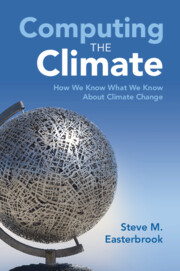Book contents
- Computing the Climate
- Epigraph
- Computing the Climate
- Copyright page
- Contents
- Preface
- Acknowledgements
- 1 Introduction
- 2 The World’s First Climate Model
- 3 The Forecast Factory
- 4 Taming Chaos
- 5 The Heart of the Machine
- 6 The Well-Equipped Physics Lab
- 7 Plug and Play
- 8 Sound Science
- 9 Choosing a Future
- References
- Index
6 - The Well-Equipped Physics Lab
Published online by Cambridge University Press: 10 August 2023
- Computing the Climate
- Epigraph
- Computing the Climate
- Copyright page
- Contents
- Preface
- Acknowledgements
- 1 Introduction
- 2 The World’s First Climate Model
- 3 The Forecast Factory
- 4 Taming Chaos
- 5 The Heart of the Machine
- 6 The Well-Equipped Physics Lab
- 7 Plug and Play
- 8 Sound Science
- 9 Choosing a Future
- References
- Index
Summary
Climate models provide a “virtual laboratory” for experiments that cannot be done on the real planet. A large community of scientists runs their own experiments on these models, and collects observations from the real world to see if these match what happens in the experiments. In climate science, the sharing of computer models helps build such a community by making it easier for scientists to develop their own experiments. Shared models also remove any mystery around an experiment, because the program code in the model is a precise, unambiguous statement of what the experiment does. The development of such a community was a crucial step forward for climate science, and, as we shall see, the National Centre of Atmospheric Research, in Boulder, Colorado played a central role in the development of this community.
- Type
- Chapter
- Information
- Computing the ClimateHow We Know What We Know About Climate Change, pp. 158 - 201Publisher: Cambridge University PressPrint publication year: 2023

